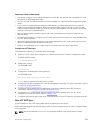
– VLT allows multiple active parallel paths from access switches to VLT chassis.
– VLT supports port-channel links with LACP between access switches and VLT peer switches. Dell
Networking recommends using static port channels on VLTi.
– If VLTi connectivity with a peer is lost but the VLT backup connectivity indicates that the peer is
still alive, the VLT ports on the Secondary peer are orphaned and are shut down.
* In one possible topology, a switch uses the BMP feature to receive its IP address, configuration
files, and boot image from a DHCP server that connects to the switch through the VLT domain.
In the port-channel used by the switch to connect to the VLT domain, configure the port
interfaces on each VLT peer as hybrid ports before adding them to the port channel (refer to
Connecting a VLT Domain to an Attached Access Device (Switch or Server)). To configure a
port in Hybrid mode so that it can carry untagged, single-tagged, and double-tagged traffic,
use the portmode hybrid command in Interface Configuration mode as described in
Configuring Native VLANs.
* For example, if the DHCP server is on the ToR and VLTi (ICL) is down (due to either an
unavailable peer or a link failure), whether you configured the VLT LAG as static or LACP, when
a single VLT peer is rebooted in BMP mode, it cannot reach the DHCP server, resulting in BMP
failure.
• Software features supported on VLT port-channels
– In a VLT domain, the following software features are supported on VLT port-channels: 802.1p,
ingress and egress ACLs, BGP, DHCP relay, IS-IS, OSPF, active-active PIM-SM, PIM-SSM, VRRP,
Layer 3 VLANs, LLDP, flow control, port monitoring, jumbo frames, IGMP snooping, sFlow, ingress
and egress ACLs, and Layer 2 control protocols RSTP only).
NOTE: PVST+ passthrough is supported in a VLT domain. PVST+ BPDUs does not result in an
interface shutdown. PVST+ BPDUs for a nondefault VLAN is flooded out as any other L2
multicast packet. On a default VLAN, RTSP is part of the PVST+ topology in that specific
VLAN (default VLAN).
– For detailed information about how to use VRRP in a VLT domain, refer to the following VLT and
VRRP interoperability section.
– For information about configuring IGMP Snooping in a VLT domain, refer to VLT and IGMP
Snooping.
– All system management protocols are supported on VLT ports, including SNMP, RMON, AAA, ACL,
DNS, FTP, SSH, Syslog, NTP, RADIUS, SCP, TACACS+, Telnet, and LLDP.
– Enable Layer 3 VLAN connectivity VLT peers by configuring a VLAN network interface for the same
VLAN on both switches.
– Dell Networking does not recommend enabling peer-routing if the CAM is full. To enable peer-
routing, a minimum of two local DA spaces for wild card functionality are required.
• Software features supported on VLT physical ports
– In a VLT domain, the following software features are supported on VLT physical ports: 802.1p,
LLDP, flow control, IPv6 dynamic routing, port monitoring, and jumbo frames.
• Software features not supported with VLT
– In a VLT domain, the following software features are supported on non-VLT ports: 802.1x, DHCP
snooping, FRRP, ingress and egress QOS.
• VLT and VRRP interoperability
– In a VLT domain, VRRP interoperates with virtual link trunks that carry traffic to and from access
devices (refer to Overview). The VLT peers belong to the same VRRP group and are assigned
master and backup roles. Each peer actively forwards L3 traffic, reducing the traffic flow over the
VLT interconnect.
– VRRP elects the router with the highest priority as the master in the VRRP group. To ensure VRRP
operation in a VLT domain, configure VRRP group priority on each VLT peer so that a peer is either
948
Virtual Link Trunking (VLT)


















